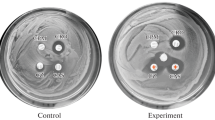Summary
We studied the activity of cefotaxime both microbiologically and clinically. 138 blood cultures positive for gram-positive cocci were evaluated (90 strains ofStaphylococcus aureus, 25 ofStreptococcus faecalis, 13 ofStreptococcus α and ten ofStreptococcus mutans). Cefotaxime showed good activity against all strains with the exception ofS. mutans, of which only 30% were sensitive. Ten cases of gram-positive infections were studied clinically: six sepsis cases and one endocarditis case due toS. aureus, two sepsis cases caused byStreptococcus α and oneEnterococcus endocarditis case. Therapy was successful in nine; theS. aureus endocarditis failed. The local and general tolerance of cefotaxime was good.
Zusammenfassung
Wir führten mikrobiologische und klinische Studien zur Wirksamkeit von Cefotaxim durch. 138 Blutkulturen, aus denen grampositive Kokken (90 Stämme vonStaphylococcus aureus, 25 Stämme vonStreptococcus faecalis, 13 Stämme von alpha-hamolysierenden Streptokokken und zehn Stämme vonStreptococcus mutans) isoliert worden waren, wurden ausgewertet. Cefotaxim zeigte gute Wirksamkeit gegen alle Stämme mit Ausnahme vonS. mutans mit lediglich 30% empfindlichen Stämmen. Klinische Studien wurden bei zehn Patienten mit grampositiven Infektionen durchgeführt, sechs litten unter Sepsis, einer unter Endokarditis durchS. aureus, zwei hatten eine Sepsis durch alpha-hämolysierende Streptokokken und einer eine Enterokokken-Endokarditis. Bei neun Patienten war die Therapie erfolgreich. Der Patient mitS. aureus-Endokarditis sprach nicht an. Die lokale und allgemeine Verträglichkeit von Cefotaxim war gut.
Similar content being viewed by others
Literature
Smith, I. M., Bentley, D. W., Bisno, A. L. Staphylococci and streptococci. In:Mandell, G. L., Douglas, R. G., Jr., Bennet, J. (eds.): Principles and practice of infectious diseases. J. Wiley & Sons, New York 1979, pp. 1530–1561.
Hamilton-Miller, J. M. T., Brumfitt, W., Reynolds, A. V. Cefotaxime (HR 756), a new cephalosporin with exceptional broadspectrum activityin vitro. J. Antimicrob. Chemother. Suppl. 4 (1978) 437–444.
Yourassowky, E., van der Linden, M. P., Lismont, M. J., Crokcert, F. Activity of ten cephalosporins on biomass of methicillin-susceptible and resistantStaphylococcus aureus. Antimicrob. Agents Chemother. Suppl. 17 (1980) 856–860.
Mouton, R. P., Bongaerts, G. P. A., van Gestel, M. Comparison of activity and beta-lactamase stability of cefotaxime with those of six other cephalosporins. Antimicrob. Agents Chemother. Suppl. 17 (1979) 757–760.
Peters, G., Pulverer, G. Comparativein vitro activity of cefotaxime (HR 756). Chemotherapy 26 (1980) 177–183.
Watanakunakorn, C. Treatment of infections due to methicillin-resistantStaphylococcus aureus. Ann. Intern. Med. Suppl. 97 (1982) 376–379.
Solberg, C. O., Digranes, A., Kalager, T. Therapy of staphylococcal septicaemia in compromised hosts. Scand. J. Infect. Dis. Suppl. 41 (1983) 177–184.
Meyers, B. R. Clinical experience with cefotaxime in the treatment of patients with bacteremia. Rev. Infec. Dis. Suppl. 4 (1982) 411–415.
Bint, A. J., Hamilton, P. J., Charlton, J., Hiller, C.: Cefotaxime plus gentamicin therapy for febrile neutropenic patients. 20th Interscience Conference Antimicrob. Agents Chemother. Seattle 1980, Abstract no. 21.
Neu, H. C.: Comparative activity of new cephalosporins against beta-lactamase-producing bacteria: In:Nelson, J. D., Grassi, C. (eds.): Current chemotherapy and infectious diseases. Vol. 1. Washington D. C. 1980, p. 23.
Gaya, H., Sacks, T., Good, A., Upton, C., Glicksman, C.: Synergy between some newer aminoglycosides and beta-lactam antibiotics. In:Nelson, J. D., Grassi, C. (eds.): Current chemotherapy and infectious diseases. Vol. I. Washington D. C. 1980, p. 485.
Watanakunakorn, C., Tisone, J. C. Synergism between vancomycin and gentamicin or tobramycin for methicillin-susceptible and methicillin-resistantStaphylococcus aureus. Antimicrob. Agents Chemother. Suppl. 22 (1982) 903–909.
Bartholomew, L. R., Minns, G. O., Voth, D. W.: Survivorship ofStreptococcus faecalis that exhibit the “Eagle Effect”. 24th Interscience Conference Antimicrob. Agents Chemother. Washington 1984, Abstract no. 1117.
Armengaud, M., Massip, P., Aubertin, J., Raynaud, J. M. Cefotaxime in the treatment of septicaemia and endocarditis. J. Antimicrob. Chemother. Suppl. 14 (1980) 263–268.
Karakusis, P. H., Feczko, J. M., Goodman, L. J., Hanson, D. M., Harris, A. A., Levin, S., Tenholme, G. M. Clinical efficacy of cefotaxime in serious infections. Antimicrob. Agents Chemother. Suppl. 21 (1982) 119–124.
Author information
Authors and Affiliations
Rights and permissions
About this article
Cite this article
Bassetti, D., Solbiati, M. & Fraizzoli, G. Clinical experience of cefotaxime in infections caused by gram-positive pathogens. Infection 13 (Suppl 1), S112–S114 (1985). https://doi.org/10.1007/BF01644230
Issue Date:
DOI: https://doi.org/10.1007/BF01644230




